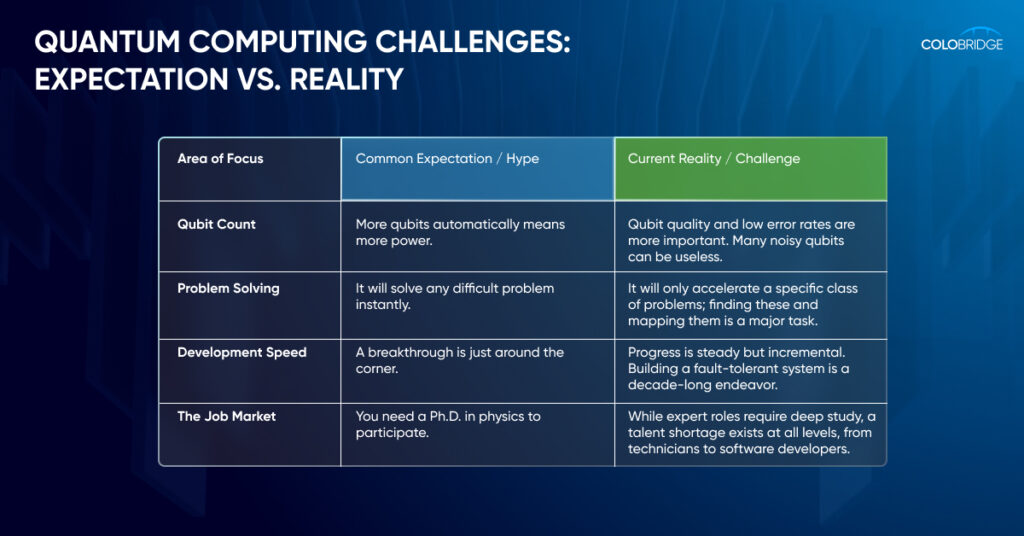Author: Bakhmat M.
Key Takeaways for Industry Leaders
- Qubit quality over quantity: The primary technical hurdle is not just building more qubits, but making them stable and correcting their errors. This fragility is the central challenge.
- Practical advantage is not yet here: The industry has demonstrated computational supremacy on abstract problems, but the next milestone is proving a “quantum advantage” on a commercially relevant task.
- The talent gap is a major roadblock: A severe shortage of quantum-ready professionals is slowing adoption. Widespread education in quantum computing is essential to build the future workforce.
- Investment is a long-term game: Quantum computing requires significant, patient capital. The recent focus on AI has shifted some investment, reinforcing the long-term nature of quantum R&D.
- The security threat is immediate: The “harvest now, decrypt later” strategy by adversaries makes the transition to post-quantum cryptography an urgent priority for all organizations.
Why Are Quantum Computers So Difficult to Build and Scale?
Building a useful quantum computer is a monumental scientific and engineering feat. Unlike classical computers, which manipulate definite 0s and 1s, quantum systems operate on probabilistic and fragile quantum bits (qubits).
- Inherent Qubit Fragility: Qubits are incredibly sensitive to their environment. Any interaction with heat, vibration, or electromagnetic fields—collectively known as “noise”—can cause them to lose their quantum information (a process called “decoherence”). This introduces errors that can ruin a computation. The central goal of quantum hardware development is achieving fault tolerance through quantum error correction.
- The Engineering Challenge of Scale: Scaling up requires more than just adding qubits. It involves orchestrating millions of components in an integrated system, all while maintaining isolation from noise. Most leading systems, including Google’s, require extreme cryogenic environments colder than deep space, adding immense complexity and cost to the engineering process.
What is the Path from Theoretical Algorithms to Practical Quantum Advantage?
The ultimate goal is to use quantum computers to solve problems that are intractable for even the most powerful classical supercomputers. However, a significant gap remains between theoretical promise and practical application.
- Beyond Academic Benchmarks: The industry has successfully demonstrated “quantum supremacy” on specific, academic tasks like Random Circuit Sampling. While a crucial scientific milestone, these tasks have no known real-world use. The next great challenge is to demonstrate a useful, beyond-classical computation that provides value to a business or scientific field.
- A Specialized Tool, Not a Replacement: Quantum computers will not be better at everything. They are specialized accelerators designed for specific types of problems, such as simulating molecules for drug discovery or optimizing complex logistical systems. For most everyday tasks, classical computers will remain the tool of choice.

How Does the Talent Gap Impact Quantum Adoption?
The most powerful hardware is useless without skilled people to design, build, and program it. The current shortage of quantum-ready talent is one of the most significant barriers to growth.
According to a 2022 McKinsey report, fewer than half of quantum jobs were projected to be filled by 2025, highlighting a wide skills gap. This shortage slows down R&D at quantum companies and prevents potential customers from exploring applications. To solve this, a global effort to expand education in quantum computing is required, moving beyond university physics departments to vocational schools, online platforms, and internal corporate training programs.
What is the Current Status and Future Outlook?
The quantum industry is in a phase of intense, focused engineering. Companies are publishing clear roadmaps that signal a shift from pure research to building functional, error-corrected systems.
Major players are tackling the challenge head-on. IBM’s roadmap targets 200 logical qubits by 2029, while here at Google Quantum AI, our goal is to build a fault-tolerant machine with 1 million physical qubits by the end of the decade. Our focus is on demonstrating a clear computational advantage on scientifically or commercially relevant tasks. Recent advancements in error correction, demonstrated on our latest processors, show that we are on a viable path.
The convergence of improved hardware, advanced software, and a growing, educated workforce will unlock the next phase of quantum adoption and bring us closer to solving problems once thought impossible.
Frequently Asked Questions (FAQ)
1. What is the single biggest challenge in quantum computing?
The core challenge is qubit fragility. Qubits are inherently noisy and prone to errors. Overcoming this through Quantum Error Correction—using many physical qubits to create a single, stable “logical qubit”—is the central focus of the entire field.
2. Will quantum computers make my current computer obsolete?
No. Quantum computers are not designed to replace classical computers for tasks like Browse the internet, sending emails, or gaming. They are specialized machines designed to tackle a specific class of problems that are mathematically too complex for any classical computer.
3. How can I or my team start learning about quantum computing?
The ecosystem for quantum education is growing rapidly. Many universities now offer specialized degrees. For accessible starting points, there are numerous online quantum computing courses, including our free introductory course on Coursera and IBM’s learning platform. Engaging with open-source software libraries like Google’s Cirq is also a great hands-on way to learn.
4. What is “harvest now, decrypt later”?
This is a cybersecurity threat where adversaries collect and store large amounts of today’s encrypted data. They are holding it with the expectation that once a sufficiently powerful quantum computer is built, they can use it to break the current encryption and decrypt the stored data. This is why developing and migrating to post-quantum cryptography is so urgent.





